On the night of 8th / 9th June 1944 the crew of this 426 Squadron were to undertake an operational flight to bomb railway facilities at Mayenne, France. They took off from Linton on Ouse airfield at 22.59hrs and the whole flight was flown in poor weather conditions but they located the target area and released bombs at around 01.40hrs and made for home. Numerous returning aircraft on this night struggled to locate their home airfields because of the poor visibility, this crew managed to get to the general Linton on Ouse area and joined the landing circuit but because of the visibility they were instructed to orbit the general area of the airfield flying at 5,000 feet rather than attempt to land. Just before 04.10hrs the crew had been ordered to divert to Nutts Corner in Northern Ireland to land but the crew realised that their remaining fuel would not be enough so opted to try and land at Linton on Ouse. They safely dropped down through the cloud to between 1,000 and 800 feet and, as dawn was breaking, could see aspects of the runway and airfield through breaks in the cloud. They began another circuit of the airfield at that height and lowered the undercarriage in preparation to land but at that same time the starboard inner engine stopped and immediately caught fire. Control and height was immediately lost and before the pilot could regain proper control of the aircraft it crashed into houses along Back Lane in the village of Newton on Ouse. A fire at the crash site broke out. The mid upper gunner was thrown out of the wreckage as it broke up during the crash and he then successfully located and pulled four members of his crew clear of a fire that had broke out. Unfortunately three of these airmen were already dead but he was responsible for his pilot surviving the crash. He then assisted in rescuing four civilians from a burning house, including Mrs Jane Storr who was buried under masonary and aircraft wreckage. For his actions he was later awarded he British Empire Medal and the citation given below adds much more detail.
An investigation was carried out into what caused the engine failure. It was found that a cylinder had completely blown off the starboard inner engine resulting in total engine failure and the engine to catch fire. Although the pilot of the aircraft was an experienced Halifax pilot because control had been lost at just 800 feet above the ground there was not enough height left for him to recover the aircraft in the space available and the aircraft crashed. The Bristol Aircraft Company sent a number of aero engine specialists to Linton on Ouse to investigate this problem and also a number of identical problems found in the Bristol Hercules engine fitted to the Halifax type. It was thought that a manufacturing fault may have been to blame, bolts or nuts may not have been tightened correctly and had worked loose. A Court of Inquiry was held into the accident but as yet I have not located a copy in Canadian archives, I suspect it is held within the surviving pilot's service file and is not yet in the public domain.
Pilot - P/O Neal Leonard Craig RCAF (J/86042), of Victoria, British Columbia, Canada. Seriously injured.
Second Pilot - F/O Douglas Rendall Parker RCAF (J/26120), aged 27, of Ottawa, Ontario, Canada. Buried Harrogate Stonefall Cemetery, Yorkshire (B/F/16).
Navigator - P/O Arthur George Sootheran RCAF (J/86393), aged 23, of Niagara Falls, Ontario, Canada. Buried Harrogate Stonefall Cemetery, Yorkshire (B/F/14).
Wireless Operator / Air Gunner - P/O Robert Carlton Parker RCAF (J/88092), aged 22, of Edmonton, Alberta, Canada. Buried Harrogate Stonefall Cemetery, Yorkshire (B/F/13). Died of injuries.
Flight Engineer - Sgt Francis Henry George Howard RAFVR (1313807), aged 21, wife of Flore, Northamptonshire. Buried Streatham Cemetery, Surrey.
Bomb Aimer - P/O William Holenchuk RCAF (J/85619), aged 25, of Hamilton, Ontario, Canada. Buried Harrogate Stonefall Cemetery, Yorkshire (B/F/15).
Rear Gunner - Sgt James Patrick Hughes RAFVR (1566653), aged 21, of Glasgow, Buried St.Kentigern's RC Cemetery, Glasgow.
Mid Upper Gunner - Sgt Eric Stewart Neill RCAF (R/187721), of Windsor, Ontario, Canada. Slightly injured.
It would be correct to add Eric Neill's service record here first as it adds much more detail in respect of this accident. He was born in Windsor, Ontario, Canada in August 1922 and was living there when he enlisted for RCAF service in September 1942. He was posted to the UK in August 1943. Eric Neill was awarded the British Empire Medal for his actions at the crash site, Gazetted on 20th October 1944. Hugh Halliday has located the recommendation for the award of the Air Force Medal in respect of his actions at the crash site of Halifax LK598, dated 9th July 1944, this states that.. "Flight Sergeant Neill was the mid-upper gunner of a heavy bomber which crashed into some houses in the village of Newton when preparing to land at his base on return from operations. The aircraft was scattered over considerable area demolishing a house which immediately caught fire. Flight Sergeant Neill managed to extricate himself from the burning aircraft wreckage and with great presence of mind and courage succeeded in dragging out four others, namely, Pilot Officer N. Craig (pilot), Pilot Officer Parker (second pilot), Pilot Officer Sootheran (navigator), WO2 R.C.Parker (wireless operator). Three of these were found later to be dead but the pilot, Pilot Officer Craig, who was dangerously injured and rescued by Flight Sergeant Neill, undoubtedly owes his life to the quick thinking and gallant action of this Non-Commissioned Officer. By this time the village fire fighters had arrived and Flight Sergeant Neill assisted in rescuing two women and two very young children who were trapped in the demolished and burning building. Flight Sergeant Neill, by his gallant action and with complete disregard for his personal safety, displayed exceptional coolness and outstanding devotion to duty in extricating these persons from a perilous situation. He is highly recommended for the immediate award of the Air Force Medal". The recommendation for the A.F.M. was changed to that of a British Empire Medal a few days later. He received a commission in July 1944 but was repatriated to Canada in November 1944 possibly having been posted to 420 Squadron just prior to this. It was not until June 1949 that he was presented with his B.E.M. Unfortunately he died in January 1966.
Linton on Ouse airfield record book mentions other individuals for their "highly commendable actions" surrounding this incident. Cpl R J Swift RAFVR (1876445)(RAF Police) who, with Eric Neill, rescued P/O Craig (and probably the other named deceased aircrew). Mr Bentley (carpenter working at Linton on Ouse aerodrome), Cpl D T Low RCAF (R/102887)(Fire Section), LAC D H Gill RCAF (R/102461)(Fire Section), LAC J Deschenes RCAF (R/177212)(Fire Section), Cpl H Abbott RAFVR (1141818)(RAF Police) all located and extracted an elderly lady from the destroyed and burning house. Finally F/Sgt E C H Edmans RAFVR (1384928), wireless operator / air gunner with 426 Squadron but whom was in Station Sick Quarters, he witnessed the crash and "with commendable presence of mind at once notified Station Flying Control by telephone. His prompt actions in so doing enabled the fire fighting equipment to be despatched at least ten minutes ahead of the next notification and undoubtedly permitted the saving of valuable property and possibly human life."
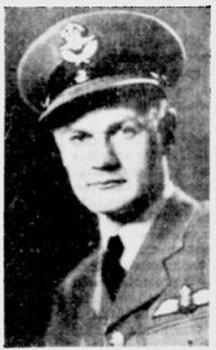
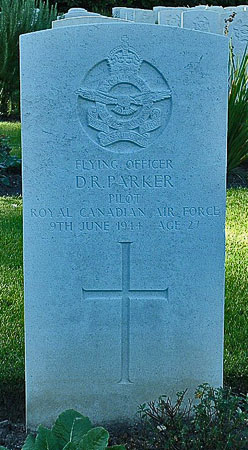
Douglas Parker was born on 16th December 1916 in Toronto, Ontario, Canada and was the son of John Spence and Elizabeth (nee Steele) Parker. As a young man he initially worked as a mechanic and petrol station attendant then undertook an apprenticeship as a photographer for three years. After this three years he set up his own business undertaking photography work under the name Parker's Studio in Ottawa. He worked for himself for two years until enlisting for RCAF service way back on 13th September 1939 in Ottawa, he then served in the RCAF as a photographer until remustering for aircrew duties in 1942. After aircrew training he was awarded his pilot's flying badge and was also granted a commission on 30th April 1943. He arrived in the UK in Summer 1943 and after training at 18 (P)AFU, 82 OTU and 1664 HCU was posted to 426 Squadron on 6th June 1944 with his own crew. He was flying as second pilot with P/O Craig's crew for operational experience when he was killed three days later.

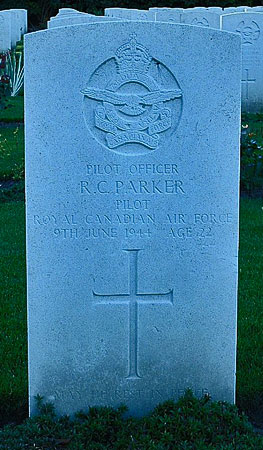
Robert Parker was born on 31st January 1922 at Edmonton, Alberta, Canada and was the son of Benjamin Wales and Mary Angeline (nee Brunelle) Parker. Both his parents were born in the USA but became naturalized Canadian citizens but his mother died in 1937. As a young man Robert left college in 1940 and worked in a creamery. He enlisted for RCAF service on 13th May 1941 in Edmonton and after training in Canada was awarded his air gunner's flying badge on 3rd August 1942 followed soon after by the wireless operator part. He arrived in the UK in Summer 1943 and after training at 4 (O)AFU, 22 OTU, 1666 HCU and 1679 CF he was posted to 426 Squadron on 4th February 1944. He was pulled from the wreckage of Halifax LW598 but sustained fatal injuries, sadly dying of these injuries later the same day. He had probably received a commission after his death, back dated to 8th June 1944. For some reason the CWGC database lists Robert Parker as being a pilot when all his service records state that he was a wireless operator.
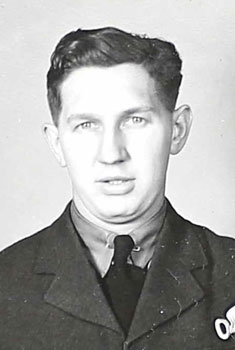
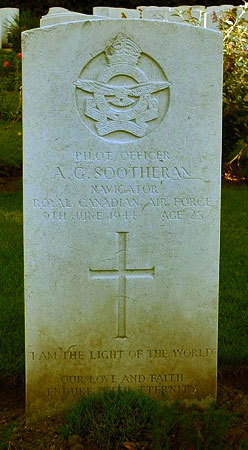
Arthur Sootheran was born on 15th January 1921 at Niagara Falls, Ontario, Canada and was the son of Herbert John and Emma Louise (nee Brewer) Sootheran. As a young man he worked as a wire drawer for the Niagara Wire Weaving Company. He undertook a pre-enlistment pilot / observer WETP course at the Ontario Training College in Hamilton in early 1942. He then enlisted for RCAF service in Hamilton on 16th April 1942 and after training in Canada he was awarded his air observer's flying badge on 19th February 1943. A day later he married Lorraine Roslyn Lorenzo in Niagara Falls. He left Canada for service in the UK in March 1943 and trained at 2 (O)AFU, 22 OTU, 1666 HCU and 1679 CF before posting to 426 Squadron on 4th February 1944. He was then granted a commission on 17th May 1944. His brother Charles served in the RCAF overseas.
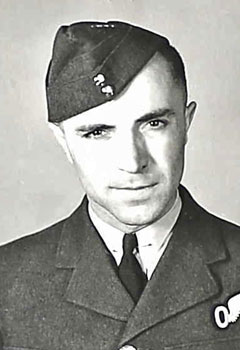
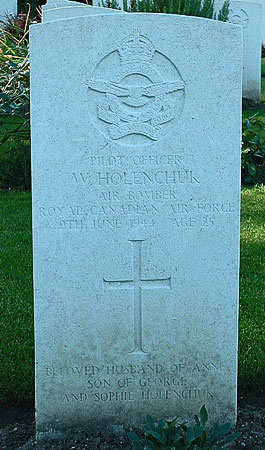
William Holenchuk was born on 12th April 1919 at Gonor, Manitoba, Canada and was the son of George and Sofie (nee Bloshot) Holenchuk. His parents appear to have both been born in the Bukovina area of Romania/Ukraine (Austria at the time) and had both emigrated to Canada. His mother died in 1928 and his father re-married the following year. William attended school in Manitoba but then moved to Ontario. As a young man he undertook various jobs including truck driving, gold mining and latterly at a nickel mine at Sudbury, Ontario. He married Annie Polesky and the couple had two children. He also undertook a pre-enlistment pilot / observer WETP course at the Ontario Training College in Hamilton in early 1942. He then enlisted for RCAF service in Hamilton on 6th April 1942 and after training in Canada he was awarded his air observer's badge (after bomb aimer training) on 19th March 1943. He arrived in the UK in Summer 1943 and following training at 4 (O)AFU, 22 OTU, 1666 HCU and 1679 CF he was posted to 426 Squadron on 4th February 1944. He received a commission on 21st March 1944.

Part of the crash site.

A memorial at the crash site was proposed by Guy Jefferson BEM and erected in May 1995 in Back Lane, Newton on Ouse. Guy was responsible for a fantastic piece of research in the 1990s that briefly documented all serious flying accidents in Yorkshire in a database that is housed at the Yorkshire Air Museum. His website at "www.newton-on-ouse-history.com" has a version of this database in downloadable format.
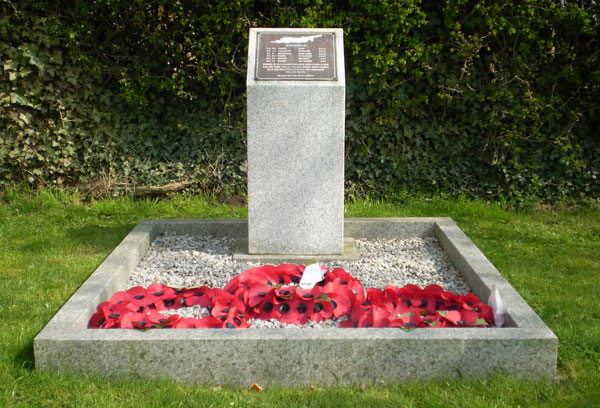

Neal Craig survived but took many years to physically recover. He died in 1998. His widow later visited the memorial in Newton on Ouse.